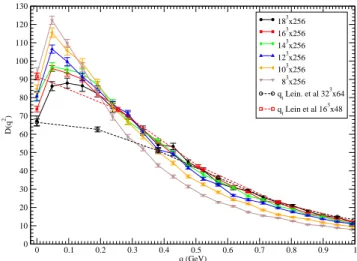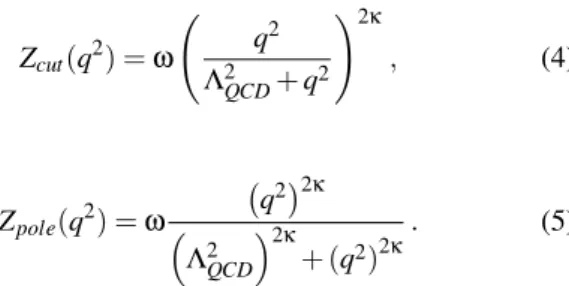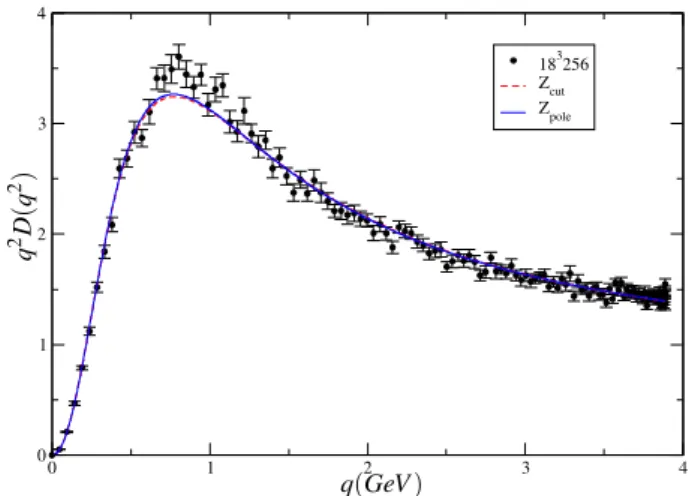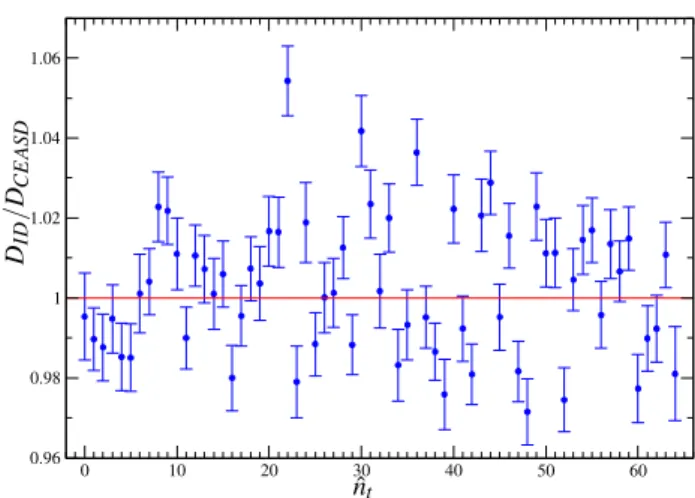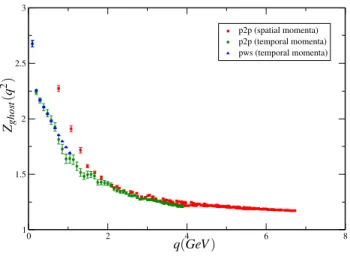Exploring the Infrared Gluon and Ghost Propagators Using Large Asymmetric Lattices
O. Oliveira and P. J. Silva Centro de F´ısica Computacional
Departamento de F´ısica, Universidade de Coimbra P-3004-516 Coimbra
Portugal
(Received on 21 September, 2006)
We report on the infrared limit of the quenched lattice Landau gauge gluon propagator computed from large asymmetric lattices. In particular, the compatibility of the pure power law infrared solution(q2)2κof the
Dyson-Schwinger equations is investigated and the exponentκis measured. The lattice data favoursκ∼0.52, which would imply a vanishing zero momentum gluon propagator as predicted by the Kugo-Ojima confinement mech-anism and the Zwanziger horizon condition. Results for the ghost propagator and for the running coupling constant are shown.
Keywords: Lattice QCD; Landau gauge; Confinement; Gluon propagator; Ghost propagator; Running coupling constant
I. INTRODUCTION AND MOTIVATION
The mechanism of quark and gluon confinement is not fully understood yet. The study of the fundamental Green’s func-tions of Quantum Chromodynamics (QCD), namely the gluon and ghost propagators, can help in the understanding of such mechanism. Indeed, there are gluon confinement criteria con-nected with the behaviour of the propagators at zero momen-tum. In particular, the Zwanziger horizon condition implies a null zero momentum gluon propagatorD(q2), and the Kugo-Ojima confinement mechanism requires an infinite zero mo-mentum ghost propagatorG(q2). The violation of positivity for the gluon propagator can also be seen as a signal for con-finement [1].
In QCD, the investigation of its infrared limit has to rely on non-perturbative methods like the Dyson-Schwinger equa-tions (DSE) and lattice QCD. Both methods have good and bad features, namely we can solve analitically the DSE in the infrared, but one has to rely on a truncation of an infinite tower of equations. On the lattice, one includes all non-perturbative physics, but one has to care about finite volume and finite lat-tice spacing effects.
Recent studies of Dyson-Schwinger equations obtained a pure power law behaviour for the infrared gluon and ghost dressing functions,
Zgluon(q2)≡q2D(q2)∼(q2)2κ (1) Zghost(q2)≡q2G(q2)∼(q2)−κ, (2) withκ=0.595 [2], which implies a vanishing (infinite) gluon (ghost) propagator for zero momentum. Studies using func-tional renormalization equations [3, 4] provided bounds in the possible values of the infrared exponent 0.52<κ<0.595. The infrared exponent obtained from time independent sto-chastic quantisation [5] is within these bounds (κ=0.52145). As an infrared (IR) analytical solution of DSE, the pure power law is valid only for very low momenta. In figure 1, the DSE gluon and ghost propagators [6] are compared with the corresponding pure power law solution. Note that for the gluon propagator the power law is valid only for momenta
below 200 MeV, and for the ghost the infrared solution is re-stricted to even lower momenta. If one wants to use lattice QCD to check for a pure power law behaviour, certainly one should consider a lattice volume sufficiently large to accomo-date a minimum number of points in the region of interest. For symmetric lattices this would require a too large volume. A cheaper solution is the use of large asymmetric latticesLs3×Lt, withLt≫Ls. For example, in [7–12] we use a set of asym-metric lattices withLt=256 andLs=8,10, . . . ,18 (see [10] for the technical details of the simulations). The large tempo-ral size of these lattices allow to access to momenta as low as 48 MeV. Of course, the price to pay are finite volume effects caused by the small value ofLs.
0 0.2 0.4 0.6 0.8
0 0.5 1 1.5
gluon DSE (cont.) gluon power law
0 10 20
ghost DSE (cont.) ghost power law
q(GeV)
Zgl
uon
(
q
2)
Zgho
st
(
q
2)
FIG. 1: The DSE solution for the gluon and ghost dressing functions [6] compared with the corresponding pure power laws.
propagator, such effects have been already investigated in [9]. Furthermore, in [9, 10] it is shown that the approachLs→+∞ is smooth. Indeed, a quick look at the gluon and ghost data in [13], again, suggests that the approachLs→+∞is smooth, i. e. that the largest symmetric propagators can be obtained by extrapolation of the asymmetric ones. In what concerns the quantitative results coming from a single large asymmetric lattice, all the above studies show that they provide, at least, a bound on the infinite volume limit. Here we report on the status of our investigations concerning the use of asymmet-ric lattices to study the infrared properties of QCD. In what concerns the positivity violation of the gluon propagator, our results can be seen in [12].
II. EXTRACTING THE INFRARED EXPONENTκFROM
THE GLUON PROPAGATOR
In [10], we have computed the gluon propagator
Dabµν(q) =δab³δ µν−
qµqν
q2 ´
D(q2) (3) for SU(3) four-dimensional asymmetric latticesLs3×256, with Ls =8,10, . . . ,18. To check that the temporal size is large enough, 164 163×128 Wilson action gauge configurations were generated. In what concerns the gluon propagator for time-like momenta, there are no differences between the 163× 128 and 163×256 data (see figure 2). This gives us confidence that the temporal extension of our lattices is sufficiently large.
0 0.5 1 1.5 2
10 20 30 40 50 60 70 80 90 100 110
163128 163256
q(GeV)
D
(
q
2)
FIG. 2: The gluon propagator for 163×128 and 163×256 lattices.
In what concerns the spatial size, it was observed that the propagator depends on the spatial size of the lattice (see figure 3). The gluon propagator decreases with the volume for the smallest momenta and increases with the volume for higher momenta.
In order to compute the infrared exponentκfrom the lattice data, we considered fits of the smallest temporal momenta of
0 0.1 0.2 0.3 0.4 0.5 0.6 0.7 0.8 0.9 1
q (GeV) 0
10 20 30 40 50 60 70 80 90 100 110 120 130
D(q
2)
183x256 163x256 143x256 123x256 103x256 83x256 qt Lein. et al 323x64 qt Lein et al 163x48
FIG. 3: The gluon propagator for all latticesL3s×256, considering
only pure temporal momenta. For comparisation, we also show the 163×48 and 323×64 propagators computed in [25].
the gluon dressing function Zgluon(q2) to a pure power law with and without polinomial corrections. The results are in table I. In general, theκvalues increase with the volume of the lattice. So, ourκcan be read as lower bounds in the infinite volume figureκ∞.
Ls z(q2)2κ z(q2)2κ(1+aq2) z(q2)2κ(1+aq2+bq4)
8 0.4496+−2229 2.14 0.4773−+3752 0.02 0.4827+−7574 0.00
10 0.4650+−3137 0.10 0.4827−+4968 0.25 0.4765+−10499 0.14
12 0.4663+−3036 1.19 0.4822−+5169 0.21 0.4849+−9497 0.18
14 0.4918+−2640 0.09 0.5053−+5267 0.16 0.4992+−10080 0.06
16 0.4859+−2224 0.40 0.5070−+3650 0.44 0.5131+−6764 1.03
18 0.5017+−4940 0.20 0.5169−+8970 0.00 0.514+−1215 0.00
TABLE I:κandχ2/d.o.f.from fitting the gluon dressing function
computed from the different latticesL3s×256. In all fits, the range of
momenta was chosen such that the fits have one degree of freedom. The lowest momentum considered being always the first nonvanish-ing momentum. The errors shown are statistical and were computed using the bootstrap method, with the number of bootstrap samples being about ten times the number of configurations.
Considering a linear or quadratic dependence on the inverse of the volume for the infrared exponent, we can try to extrap-olate the figures of table I. In what concerns the results for the pure power law fits, they are not described by these functional forms. Using the corrections to the pure power law, one gets values forκ∞in the interval[0.51,0.56]; the weighted mean
On the other hand, one can also extrapolate directly the gluon propagator, as a function of the inverse of the vol-ume, to the infinite volume limit, fitting each timelike momen-tum propagator separately. Doing so, we are taking the limit Ls→∞, assuming a sufficient number of points in the tempo-ral direction. Sevetempo-ral types of polinomial extrapolations were tried, using different sets of lattices, and we conclude that the data is better described by quadratic extrapolations of the data from the 4th and 5th largest lattices. In figure 4 the two ex-trapolations of the gluon propagator are shown. For compari-sation, we also include the 163×48 and 323×64 propagators computed in [25].
The values ofκextracted from these extrapolated propaga-tors areκ=0.5215(29), with a χ2/d.o.f.=0.02, using the largest 5 lattices in the extrapolation, and κ=0.4979(66),
χ2/d.o.f.=0.27 using the largest 4 lattices. Fitting the ex-trapolated data to the polinomial corrections to the pure power law, one can get higher values forκ. Note that the first value is on the top of the value obtained from extrapolating directly
κas a function of the volume. In conclusion, one can claim a
κ∈[0.49,0.53], with the lattice data favouring the right hand side of the interval.
0 0.1 0.2 0.3 0.4 0.5
q (GeV) 0
20 40 60 80 100
D(q
2)
qt Lein. et al 163*48
qt Lein. et al 323*64
Quadratic Ext. (5 lattices) Quadratic Ext. (4 lattices)
FIG. 4: The bare extrapolated gluon propagator for momenta below 500MeV. The errors on the propagator were computed assuming a gaussian error propagation.
III. ARE DSE FITTING FORMS REPRODUCED BY
LATTICE DATA?
In this section we will try to check if the pure temporal lat-tice data of the gluon propagator can be described by some functional forms that fitted the solution for the gluon propa-gator in Landau gauge of the Dyson-Schwinger equations re-ported in [15, 16]. Only the largest lattices will be considered.
A. The infrared region
In the IR region, the continuum DSE solution is well de-scribed by the following expressions [15],
Zcut(q2) =ω Ã
q2
Λ2 QCD+q2
!2κ
, (4)
Zpole(q2) =ω ¡
q2¢2κ ³
Λ2 QCD
´2κ
+ (q2)2κ
. (5)
The first functional form has a branch cut in the IR region. The last one has a pole in the IR region.
In what concerns the lattice propagator, both formulas pro-vide good fits up to the maximum of the dressing function — see table II and figure 5. However, the measured infrared ex-ponents are larger than those obtained assuming a pure power law for the IR region [10], and support an infrared vanishing gluon propagator.
Lattice qmax κ ΛQCD χ2/d.o.f. Zcut 163×128 570 0.5117−+4846 417+−88 1.25
163×256 664 0.5090+19 −20 409
+4
−4 0.71
183×256 711 0.5320−+2830 389+−56 1.14
Zpole 163×128 570 0.5100−+3831 416+−68 1.15 163×256 664 0.5077−+1617 409+−43 0.69
183×256 711 0.5266+29 −21 391
+3
−7 1.09
TABLE II: IR fits.qmaxis the highest momenta considered in the fit.
qmaxandΛQCDare given in MeV.
0 1 2 3 4
0 1 2 3 4
183x256 Z
cut
Z
pole
q(GeV)
q
2D
(
q
2)
The lattice propagator, for the full range of pure temporal momenta, was fitted to
Zf it(q2) = B(q2)¡α(q2)¢
−γ
, γ=−13/22, (6) withB(q2) =Zpole,cut. Two different definitions for the run-ning coupling were considered [15, 16]:
αP(q2) = 1 1+Λq22
QCD ·
α(0) + (q2/Λ2QCD)×
4π β0
³ 1
ln(q2/Λ2 QCD)
− 1
q2/Λ2
QCD−1
´¸ ; (7)
αLN(q2) =
α(0)
lnhe+a1(q2/Λ2QCD)a2
i. (8)
The fits usingαP(q2)(usingβ0=11) for the running cou-pling have a χ2/d.o.f.≥2 for L
s =16. However, for the largest lattice, 183×256, the data is well described; see table III and figure 6.
183×256 α(0) κ ΛQCD χ2/d.o.f. B=Zcut 10.92+−1318 0.5280+−3022 549+−23 1.61
B=Zpole 10.01+−1417 0.5263
+19
−22 550
+2
−3 1.54
TABLE III: Fits to all lattice data usingαP(q2).
Note that only when one usesB=Zpoletheκvalues agree with those from the IR fits. However,ΛQCDis not compatible with the IR values. The fitting form differs from the lattice data mainly at the maximum of the dressing function (∼0.8 GeV).
The lattice data adjusts better toαLN(q2)than to the pre-viously considered running coupling. Indeed, looking at the fitting results for our largest lattice (see tables IV and V), the values ofκandΛQCD are essentially the values obtained in the IR study. Moreover, on overall there is good agreement between the fitting function and the lattice data, see figure 7.
B=Zcut κ ΛQCD a1 a2 χ2/d.o.f.
163×128 0.5435+−3641 364+−44 0.0062+−33 2.44+−21 1.82
163×256 0.5244+21 −15 374
+2
−2 0.0072
+3
−3 2.42
+1
−1 1.73
183×256 0.5368+−2524 381+−34 0.0067+−45 2.55+−22 1.23
TABLE IV: Fits to all lattice data usingαLN(q2)andB=Zcut.
The running coupling at zero momentum can be measured fromαLN(q2)[7, 8] and is related with the high momentum behaviour of the running coupling,α(0) = (4π/β0)a2. The measuredα(0)are reported in table VI. Note that the values from the 163×128 and 163×256 data agree within one stan-dard deviation. Furthermore,α(0)increases withLs and the fitted values reported in table VI are around the original DSE estimation forα(0) =2.972 [2].
0 1 2 3 4
0 1 2 3 4
183256 Zcut Z
pole
q(GeV)
q
2D
(
q
2)
FIG. 6: Compatibility between our lattice data and global fits using αP(q2).
0 1 2 3 4
0 1 2 3 4
183x256 Zcut Zpole
q(GeV)
q
2D
(
q
2)
FIG. 7: Compatibility between our lattice data and global fits using αLN(q2).
B=Zpole κ ΛQCD a1 a2 χ2/d.o.f.
163×128 0.5335+−2326 373+−33 0.0081+−33 2.36+−22 1.65
163×256 0.5217+−1414 377+−22 0.0082+−33 2.36+−11 1.61
183×256 0.5300+−1721 388+−33 0.0085+−64 2.46+−23 1.20
TABLE V: Fits to all lattice data usingαLN(q2)andB=Zpole.
IV. GRIBOV COPIES EFFECTS IN THE PROPAGATORS
α(0) Zcut Zpole
163×128 2.79−+21 2.70+−22
163×256 2.77+1 −1 2.70
+1
−1
183×256 2.91−+23 2.81+−23
TABLE VI: Values ofα(0)measured fromαLN(q2).
FU[g] = CF
∑
x,µRe{Tr[g(x)Uµ(x)g†(x+µˆ)]} (9)
It is well known that this functional has, in general, several maxima, the Gribov copies [19]. To properly define a non-perturbative gauge fixing, one should choose the gauge trans-formationg(x)that globally maximizes (9). This is a global optimization problem and it is not easy to find the global max-imum of (9). In most studies of the gluon and ghost propa-gators one chooses a local maximum of (9), hoping that the Gribov copy effects in the propagators are small.
On the lattice, several studies reported Gribov effects in the ghost propagator (see, for example, [11, 17, 18], and the next section), but it is generally accepted that Gribov copies do not change significantly the gluon propagator.
However, there are some studies reporting Gribov copy ef-fects in the gluon propagator. In [20], the problem of the Gri-bov copies effects on the gluon propagator was studied, and some differences were found. It was claimed a two to three
σeffect due to Gribov copies in the low momentum region. Furthermore, it was observed, by sorting the different Gribov copies according to the value of the gauge fixing functional, that the propagator for the lowest momenta behaves monoton-ically as a function of<FU>: for zero momentum, the prop-agator increases with<FU >, and for some small non-zero momenta the propagator decreases with<FU>. There is also a study [21] where the authors claim that the enlargement of the gauge orbits allows for Gribov effects in the gluon propa-gator.
In what concerns asymmetric lattices, CEASD gauge fixing method [22] was applied to the 163×128 configurations. This global optimization method for Landau gauge fixing com-bines a genetic algorithm with a local gauge fixing method, aiming to find the global maximum of (9). The obtained gluon propagator was compared with the one computed from a local maximum of (9); this local maximum is obtained using the local gauge fixing method described in [28]. In fig. 8, we can see the ratio between the two propagators.
Although there are many momenta for which the ratio is not compatible with one, we cannot conclude in favour of any systematic effect.
0 10 20 30 40 50 60
0.96 0.98 1 1.02 1.04 1.06
ˆ
nt
D
I
D
/
DC
E
AS
D
FIG. 8: Gribov copy effects in the gluon propagator computed from 163×128 configurations.
V. GHOST PROPAGATOR AND RUNNING COUPLING
CONSTANT
A. Ghost propagator
For our smallest lattices (103×256, 123×256, 163×128), we have computed the ghost propagator [11],
Gab(q) =−δabG(q2) (10) using both a point source method [23] (we averaged over 7 different point sources to get a better statistics), and a plane-wave source [17]. In both cases we used the preconditioned conjugate algorithm, as described in [18]. The advantage of using a plane-wave source being that the statistical accuracy is much better, but we can only obtain one momentum com-ponent at a time. Using a point source method one can get all the momenta in once, but with larger statistical errors.
In figures 9 and 10 it is shown the ghost dressing func-tion Zghost(q2)for 123×256 and 163×128 computed with both methods. For the 123×256, the point source data is not smooth for a large range of momenta. This is true also for 103×256 lattice , but this effect is significantly reduced for 163×128. In what concerns finite volume effects, we see differences, in the infrared, between pure temporal and pure spatial data, as in the gluon case.
In figure 11 one can see the ghost dressing function only for the plane-wave data. As in the gluon case, we are able to evaluate the effect of Gribov copies on the lattice 163×128 by considering different gauge fixing methods. One can see clear effects of Gribov copies, as expected from other stud-ies [17, 18]. Also, we see finite volume effects if one com-pares propagators computed from lattices with different spa-tial sizes.
0 2 4 6 8 1
1.5 2 2.5 3
p2p (spatial momenta) p2p (temporal momenta) pws (temporal momenta)
q(GeV)
Zghos
t
(
q
2)
FIG. 9: Bare ghost dressing function for a 123×256 lattice; “p2p” (“pws”) stands for the ghost components computed using a point (plane wave) source.
0 2 4 6 8
1 1.5 2 2.5 3
p2p (spatial momenta) p2p (temporal momenta) pws (temporal momenta)
q(GeV)
Zghos
t
(
q
2)
FIG. 10: Bare ghost dressing function for a 163×128 lattice.
effects caused by the small spatial extension of our lattices, or to an insufficient number of points in the infrared region — note that for the ghost propagator, the pure power law lacks validity well below 200 MeV (see figure 1).
B. Running coupling constant
Using the gluon and ghost dressing functions, one can de-fine a running coupling constant as
αS(q2) =α(µ2)Zghost2 (q2)Zgluon(q2). (11) The DSE infrared analysis predicts a running coupling
con-0 0.2 0.4 0.6 0.8 1
1.5 2 2.5 3
163128 163128 (ceasd) 123256 103256
q(GeV)
Zgho
st
(
q
2)
FIG. 11: Bare ghost dressing function for all lattices. The data were computed using a plane wave method.
stant at zero momentum different from zero, αS(0) =2.972 [2]. On the other hand, the DSE solution on a torus [24], and results from lattice simulations [11, 18, 26, 27], shows a decreasing coupling constant for small momenta. Using an asymmetric lattice allow us to study smaller momenta having in mind to provide, at least, a hint to this puzzle.
Again, our lattice data shows finite volume effects, if one compares pure temporal and pure spatial momenta, see fig-ure 12. Comparing the results for all available lattices (plane-wave source), see figure 13, we can see, as in the ghost case, finite volume effects, and clear Gribov copies effects.
0 2 4 6 8
0 5 10 15 20
p2p (spatial momenta) p2p (temporal momenta) pws (temporal momenta)
q(GeV)
α
(
q
2)
/
α
(
µ
2)
FIG. 12: Running coupling constant for a 163×128 lattice.
In what concerns the infrared behaviour, we tried to fit the lowest momenta to a pure power law,(q2)κα. We concluded
0 0.5 1 1.5 0
5 10 15
163128
163128 (ceasd)
123256
103256
q(GeV)
α
(
q
2)
/
α
(
µ
2)
FIG. 13: Running coupling constant for all lattices. The data were computed using a plane wave method.
163×128 lattice, gauge fixed with CEASD method, giving
κα∼0.688, withχ2/d.o.f.∼0.011. The reader should be
aware that it is also possible, in some cases, to fit the infrared data toα(0)(1+aq2+. . .)and get aα(0)6=0. Therefore, we can not give a definitive answer about the behaviour of the run-ning coupling constant forq=0. Note, however, thatαS(q2) for the smallest momenta, seems to increase as a function of the volume.
VI. CONCLUSIONS
In this work asymmetric lattices were used to study the in-frared behaviour of QCD propagators.
In what concerns the gluon propagator, the lattice data is well described by a pure power law(q2)2κfor momenta below
150 MeV. The value of the infrared exponent increases with the volume, so our κ’s can be read as lower bounds of the infinite volume figure. Extrapolating the gluon propagator to the infinite volume limit, assuming a sufficient temporal size of our lattices, one getsκ∈[0.49,0.53]. Unfortunately, we can not give a definitive answer about the behaviour of the gluon propagator at zero momentum. Note, however, that the lattice data favours the right hand side of the given interval, and that using other fitting forms and a larger range of momenta, one always getκ>0.5.
In what concerns the ghost propagator, we were not able to extract a pure power law on the available results. We observed finite volume effects and clear Gribov copies effects on this propagator, in agreement with other studies.
Finally, we observed a decreasing running coupling for low momenta, in agreement with previous simulations.
Acknowledgements
This work was supported by FCT via grant
SFRH/BD/10740/2002, and by project POCI/FP/63436/2005.
[1] For details on these topics see, for example, R. Alkofer, L. von Smekal, Phys. Rept.353, 281 (2001), and references therein. [2] C. Lerche, L. von Smekal, Phys. Rev. D65, 125006 (2002). [3] J. M. Pawlowski, D. F. Litim, S. Nedelko, and L. von Smekal,
Phys. Rev. Lett.93, 152002 (2004).
[4] C. S. Fischer, H. Gies, JHEP0410, 048 (2004). [5] D. Zwanziger, Phys. Rev. D67, 105001 (2003).
[6] C. S. Fischer, M. R. Pennington, Phys. Rev. D 73, 034029 (2006).
[7] O. Oliveira, P. J. Silva, AIP Conf. Proc.756, 290 (2005). [8] P. J. Silva, O. Oliveira, PoS(LAT2005)286.
[9] O. Oliveira, P. J. Silva, PoS(LAT2005)287.
[10] P. J. Silva, O. Oliveira, Phys. Rev. D74, 034513 (2006). [11] O. Oliveira, P. J. Silva, accepted to Eur. Phys. J. A
[hep-lat/0609027].
[12] O. Oliveira, P. J. Silva, PoS(LAT2006)075.
[13] A. Cucchieri, T. Mendes, Phys. Rev. D73, 071502 (2006). [14] Andre Sternbeck, PhD thesis, hep-lat/0609016.
[15] R. Alkofer, W. Detmold, C.S. Fischer, and P. Maris, Phys. Rev. D70, 014014 (2004).
[16] C. S. Fischer, R. Alkofer, Phys. Rev. D67, 094020 (2003). [17] A. Cucchieri, Nucl. Phys. B508, 353 (1997).
[18] A. Sternbeck, E.-M. Ilgenfritz, M. M ¨uller-Preussker, and A. Schiller, Phys. Rev. D72, 014507 (2005).
[19] V. N. Gribov, Nucl. Phys. B139, 1 (1978).
[20] P. J. Silva, O. Oliveira, Nucl. Phys. B690, 177 (2004). [21] I. L. Bogolubsky, G. Burgio, V. K. Mitrjushkin, and M. M
¨uller-Preussker, Phys. Rev. D74, 034503 (2006).
[22] O. Oliveira, P.J. Silva, Comp. Phys. Comm.158, 73 (2004). [23] H. Suman, K. Schilling, Phys. Lett. B373, 314 (1996). [24] C. S. Fischer, B. Gruter, and R. Alkofer, Annals Phys.321, 1918
(2006).
[25] D. B. Leinweber, J. I. Skullerud, A. G. Williams, and C. Par-rinello, Phys. Rev. D60, 094507 (1999);61, 079901 (2000). [26] S. Furui, H. Nakajima, Phys. Rev. D69, 074505 (2004). [27] S. Furui, H. Nakajima, Phys. Rev. D70, 094504 (2004). [28] C. H. T. Davies, G. G. Batrouni, G. P. Katz, A. S. Kronfeld, G.
![FIG. 1: The DSE solution for the gluon and ghost dressing functions [6] compared with the corresponding pure power laws.](https://thumb-eu.123doks.com/thumbv2/123dok_br/18982619.457606/1.892.486.822.640.864/solution-gluon-ghost-dressing-functions-compared-corresponding-power.webp)
